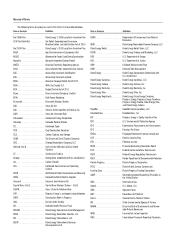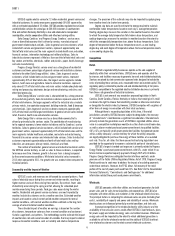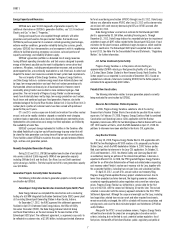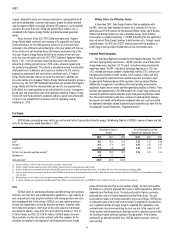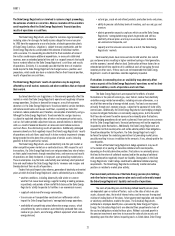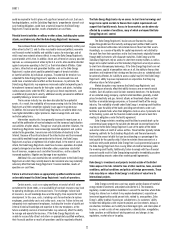Duke Energy 2012 Annual Report Download - page 33
Download and view the complete annual report
Please find page 33 of the 2012 Duke Energy annual report below. You can navigate through the pages in the report by either clicking on the pages listed below, or by using the keyword search tool below to find specific information within the annual report.
PART I
13
of 96 months. The principal difference between Zapata’s estimate and Progress
Energy Florida’s previous estimate appears to be due to the respective levels
of contingencies included by each party, including higher project risk and
longer project duration. Progress Energy Florida has fi led a copy of the Zapata
report with the FPSC and with the NRC. The FPSC held a status conference on
October 30, 2012 to discuss Duke Energy’s analysis of the Zapata report.
On February 5, 2013, following the completion of a comprehensive
analysis, Duke Energy announced its intention to retire Crystal River Unit 3.
Duke Energy concluded that it did not have a high degree of confi dence
that repair could be successfully completed and licensed within estimated
costs and schedule, and that it was in the best interests of Progress Energy
Florida’s customers and joint owners and Duke Energy’s investors to retire
the unit. Progress Energy Florida developed initial estimates of the cost to
decommission the plant during its analysis of whether to repair or retire
Crystal River Unit 3. With the fi nal decision to retire, Progress Energy Florida is
working to develop a comprehensive decommissioning plan, which will evaluate
various decommissioning options and costs associated with each option. The
plan will determine resource needs as well as the scope, schedule and other
elements of decommissioning. Progress Energy Florida intends to use a safe
storage (SAFSTOR) option for decommissioning. Generally, SAFSTOR involves
placing the facility into a safe storage confi guration, requiring limited staffi ng to
monitor plant conditions, until the eventual dismantling and decontamination
activities occur, usually in 40 to 60 years. This decommissioning approach is
currently utilized at a number of retired domestic nuclear power plants and is
one of three generally accepted approaches to decommissioning required by
the NRC. Once an updated site specifi c decommissioning study is completed
it will be fi led with the FPSC. As part of the evaluation of repairing Crystal
River Unit 3, initial estimates of the cost to decommission the plant under the
SAFSTOR option were developed which resulted in an estimate in 2011 dollars
of $989 million. See Note 9 for additional information. Additional specifi cs about
the decommissioning plan are being developed.
Progress Energy Florida maintains insurance coverage against
incremental costs of replacement power resulting from prolonged accidental
outages at Crystal River Unit 3 through NEIL. NEIL provides insurance coverage
for repair costs for covered events, as well as the cost of replacement power of
up to $490 million per event when the unit is out of service as a result of these
events. Actual replacement power costs have exceeded the insurance coverage.
Progress Energy Florida also maintains insurance coverage through NEIL’s
accidental property damage program, which provides insurance coverage up to
$2.25 billion with a $10 million deductible per claim.
Throughout the duration of the Crystal River Unit 3 outage, Progress
Energy Florida worked with NEIL for recovery of applicable repair costs and
associated replacement power costs. NEIL has made payments on the fi rst
delamination; however, NEIL has withheld payment of approximately $70 million
of replacement power cost claims and repair cost claims related to the fi rst
delamination event. NEIL had not provided a written coverage decision for either
delamination and no payments were made on the second delamination and no
replacement power reimbursements were made by NEIL since May 2011. These
considerations led Progress Energy Florida to conclude, in the second quarter of
2012, that it was not probable that NEIL would voluntarily pay the full coverage
amounts that Progress Energy Florida believes them to owe under the applicable
insurance policies. Consistent with the terms and procedures under the
insurance coverage with NEIL, Progress Energy Florida agreed to non-binding
mediation prior to commencing any formal dispute resolution. On February 5,
2013, Progress Energy Florida announced it and NEIL had accepted the
mediator’s proposal whereby NEIL will pay Progress Energy Florida an additional
$530 million. Along with the $305 million which NEIL previously paid, Progress
Energy Florida will receive a total of $835 million in insurance proceeds.
As a result of the 2012 FPSC Settlement Agreement, Progress Energy
Florida will be permitted to recover prudently incurred fuel and purchased
power costs through its fuel clause without regard for the absence of Crystal
River Unit 3 for the period from the beginning of the Crystal River Unit 3 outage
through December 31, 2016.
In accordance with the terms of the 2012 FPSC Settlement Agreement,
with consumer representatives and approved by the FPSC, Progress
Energy Florida retained the sole discretion to retire Crystal River Unit 3.
Progress Energy Florida expects that the FPSC will review the prudence of
the retirement decision in Phase 2 of the Crystal River Unit 3 delamination
regulatory docket. Progress Energy Florida has also asked the FPSC to review
the mediated resolution of insurance claims with NEIL as part of Phase 3 of
this regulatory docket. Phase 2 and Phase 3 hearings have been tentatively
scheduled to begin on June 19, 2013.
Progress Energy Florida did not begin the repair of Crystal River Unit 3
prior to December 31, 2012. Consistent with the 2012 FPSC Settlement
Agreement regarding the timing of commencement of repairs, Progress Energy
Florida recorded a Regulatory liability of $100 million in the third quarter of 2012
related to replacement power obligations. This amount is included within fuel
used in electric generation and purchased power in Progress Energy Florida’s
and Progress Energy’s Statements of Operations and Comprehensive Income
for the year ended December 31, 2012. Progress Energy Florida will refund this
replacement power liability on a pro rata basis based on the in-service date of
up to $40 million in 2015 and $60 million in 2016. This amount is refl ected as
part of the purchase price allocation of the merger with Progress Energy in Duke
Energy’s Consolidated Financial Statements.
Progress Energy Florida also retained sole discretion to retire the unit
without challenge from the parties to the agreement. As a result, Progress
Energy Florida will be allowed to recover all remaining Crystal River Unit 3
investments and to earn a return on the Crystal River Unit 3 investments set
at its current authorized overall cost of capital, adjusted to refl ect a return on
equity set at 70 percent of the current FPSC authorized return on equity, no
earlier than the fi rst billing cycle of January 2017.
In conjunction with the decision to retire Crystal River Unit 3, Progress
Energy Florida reclassifi ed all Crystal River Unit 3 investments, including
property, plant and equipment; nuclear fuel; inventory; and deferred assets to
a regulatory asset account. At December 31, 2012, Progress Energy Florida had
$1,637 million of net investment in Crystal River Unit 3 recorded in Regulatory
assets on its Consolidated Balance Sheets. Progress Energy Florida recorded
$192 million of impairment and other charges related to the wholesale portion
of Crystal River Unit 3 investments, which are not covered by the 2012 FSPC
Settlement Agreement, and other provisions. The signifi cant majority of this
amount is recorded in Impairment charges on Progress Energy Florida’s and
Progress Energy’s Consolidated Statements of Operations and Comprehensive
Income for the year ended December 31, 2012. This amount is refl ected as part
of the purchase price allocation of the merger with Progress Energy in Duke
Energy’s Consolidated Financial Statements.
In accordance with the 2012 FPSC Settlement Agreement, NEIL proceeds
received allocable to retail customers will be applied fi rst to replacement
power costs incurred after December 31, 2012 through December 31, 2016,
with the remainder used to write down the remaining Crystal River Unit 3
investments.
Progress Energy Florida believes the decision to retire Crystal River Unit 3,
the actions taken and costs incurred in response to the Crystal River Unit 3
delamination have been prudent and, accordingly, considers replacement power
and capital costs not recoverable through insurance to be recoverable through
its fuel cost-recovery clause or base rates. Additional replacement power costs
and exit cost to wind down the operations at the plant and decommission
Crystal River Unit 3 could be material. Retirement of the plant could impact
funding obligations associated with Progress Energy Florida’s nuclear
decommissioning trust fund.
Progress Energy Florida is a party to a master participation agreement
and other related agreements with the joint owners of Crystal River Unit 3 which
convey certain rights and obligations on Progress Energy Florida and the joint
owners. In December 2012, Progress Energy Florida reached an agreement with
one group of joint owners related to all Crystal River Unit 3 matters.
Progress Energy Florida cannot predict the outcome of matters
described above.


